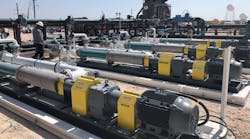A group of environmentalists has been denied access to information regarding the chemicals involved in hydraulic fracturing, after a district judge in Wyoming ruled that they were not entitled to know the ingredients of fluids used in the process, the Wyoming State Oil and Gas Conservation Commission has announced.
Natrona County District Judge Catherine Wilking decided that the coalition of environmental groups, which had expressed concerns over the possible damage that could be inflicted upon the environment if unidentified chemicals were used underground, had no right to access this information. Environmentalists argued that the public had the right to know what chemicals are being used in fracking, so that they are able to more accurately assess the risks involved in the process. According to Judge Wilking, the Wyoming State Oil and Gas Conservation Commission had "the authority to keep the ingredient lists secret," adding that the ingredients were a trade secret and the state of Wyoming's open records law could not be applied to such information.
However, she noted that the petitioners' claims that fracking fluids could be dangerous could be reasonable and the use of chemicals should be public knowledge. These concerns should be addressed through legislative action or further rule promulgation, she stated.
RELATED: Study links Oklahoma earthquake to wastewater injection
During the process of hydraulic fracturing used to extract natural gas from shale rock formations, specially formulated chemicals are used to serve as lubricants to keep the machinery running. Drilling operations involve pumping water, sand and underground fluids to crack open rocks that contain oil and gas. The chemical lubricants are used to ensure the smooth flow of sand but environmentalists are worried that these chemicals could pollute the land and water, which could be especially harmful for the land located in proximity to fracking sites.
According to Wyoming Oil and Gas Conservation Commission spokesman Renny MacKay, the court ruling is proof that the state recognized the importance of a state-based approach to fracking regulation. In a statement published by the Associated Press, he added that the state should take into consideration environmental protection along with the importance of hydraulic fracturing as a means to produce energy. The ruling was also welcomed by Gov. Matt Mead, who commented that federal regulation of hydraulic fracturing should be replaced by state-based rules.
Defendant Halliburton, the company that runs drilling operations, stated that if the ingredients used in the fluids were disclosed publicly this could give competitors the advantage of replicating successful fluids, the Associated Press reported.
The environmental groups, including the Powder River Basin Resource Council, Wyoming Outdoor Council, Earthworks and OMB Watch, are currently considering their next move and may appeal the decision.


